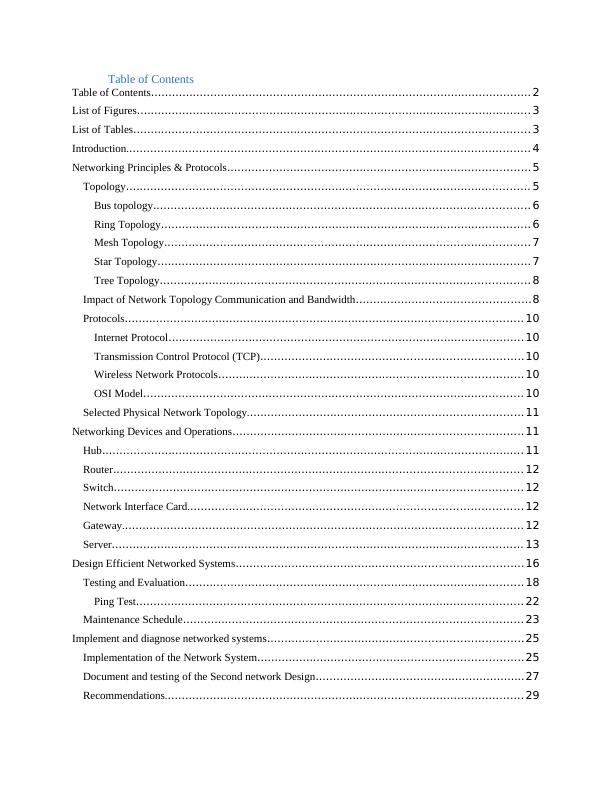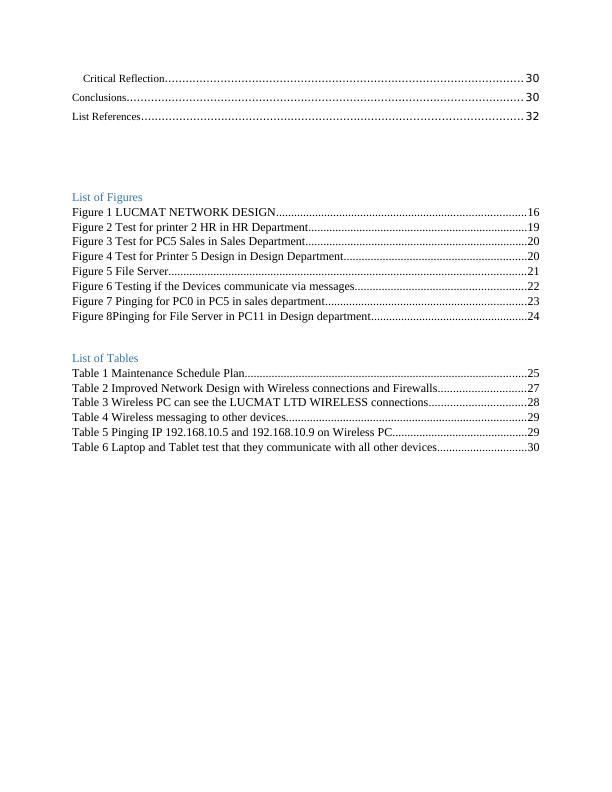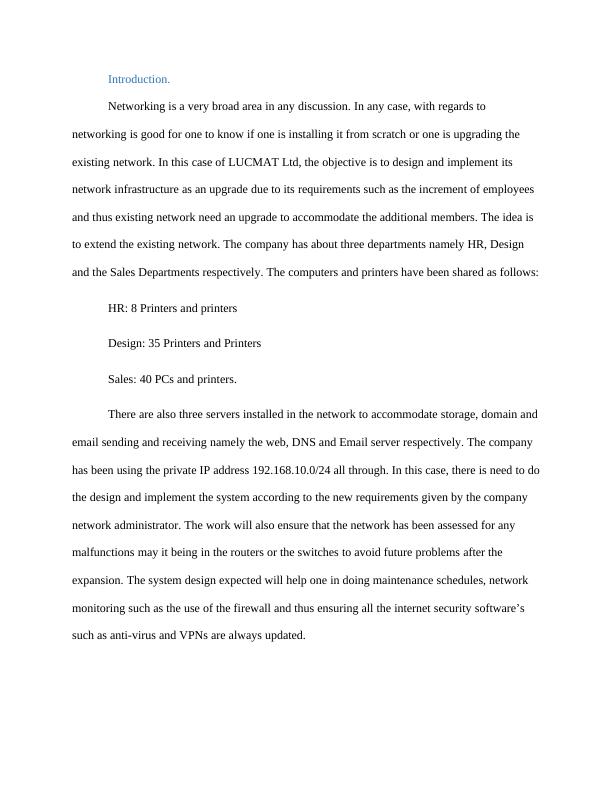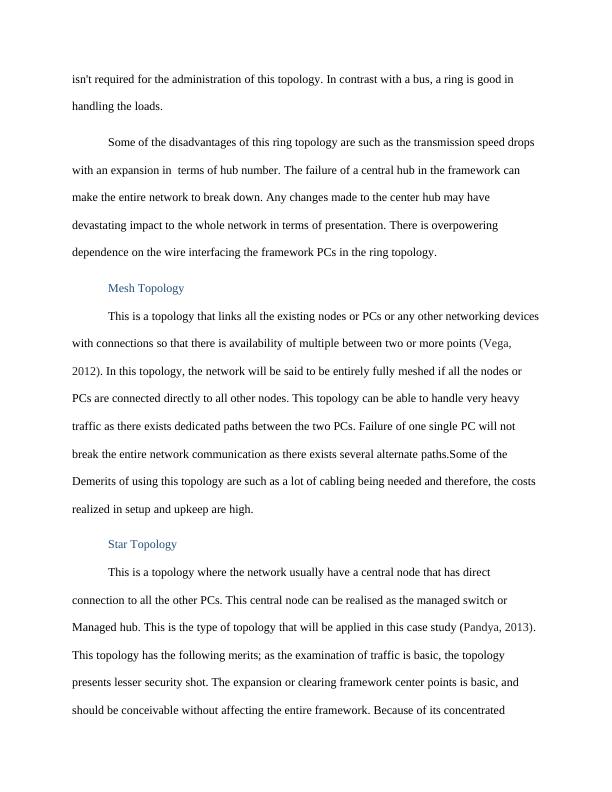Network Design: Case Study of LUCMAT LTD
Added on 2022-11-25
32 Pages6131 Words456 Views
Network Design
Case Study of LUCMAT LTD
Student Name
Institution Affiliation
Case Study of LUCMAT LTD
Student Name
Institution Affiliation

Table of Contents
Table of Contents............................................................................................................. 2
List of Figures................................................................................................................. 3
List of Tables.................................................................................................................. 3
Introduction.................................................................................................................... 4
Networking Principles & Protocols....................................................................................... 5
Topology.................................................................................................................... 5
Bus topology............................................................................................................ 6
Ring Topology.......................................................................................................... 6
Mesh Topology......................................................................................................... 7
Star Topology........................................................................................................... 7
Tree Topology.......................................................................................................... 8
Impact of Network Topology Communication and Bandwidth..................................................8
Protocols.................................................................................................................. 10
Internet Protocol...................................................................................................... 10
Transmission Control Protocol (TCP)...........................................................................10
Wireless Network Protocols....................................................................................... 10
OSI Model............................................................................................................. 10
Selected Physical Network Topology............................................................................... 11
Networking Devices and Operations................................................................................... 11
Hub......................................................................................................................... 11
Router..................................................................................................................... 12
Switch..................................................................................................................... 12
Network Interface Card................................................................................................ 12
Gateway................................................................................................................... 12
Server...................................................................................................................... 13
Design Efficient Networked Systems..................................................................................16
Testing and Evaluation................................................................................................. 18
Ping Test............................................................................................................... 22
Maintenance Schedule................................................................................................. 23
Implement and diagnose networked systems.........................................................................25
Implementation of the Network System............................................................................25
Document and testing of the Second network Design............................................................27
Recommendations....................................................................................................... 29
Table of Contents............................................................................................................. 2
List of Figures................................................................................................................. 3
List of Tables.................................................................................................................. 3
Introduction.................................................................................................................... 4
Networking Principles & Protocols....................................................................................... 5
Topology.................................................................................................................... 5
Bus topology............................................................................................................ 6
Ring Topology.......................................................................................................... 6
Mesh Topology......................................................................................................... 7
Star Topology........................................................................................................... 7
Tree Topology.......................................................................................................... 8
Impact of Network Topology Communication and Bandwidth..................................................8
Protocols.................................................................................................................. 10
Internet Protocol...................................................................................................... 10
Transmission Control Protocol (TCP)...........................................................................10
Wireless Network Protocols....................................................................................... 10
OSI Model............................................................................................................. 10
Selected Physical Network Topology............................................................................... 11
Networking Devices and Operations................................................................................... 11
Hub......................................................................................................................... 11
Router..................................................................................................................... 12
Switch..................................................................................................................... 12
Network Interface Card................................................................................................ 12
Gateway................................................................................................................... 12
Server...................................................................................................................... 13
Design Efficient Networked Systems..................................................................................16
Testing and Evaluation................................................................................................. 18
Ping Test............................................................................................................... 22
Maintenance Schedule................................................................................................. 23
Implement and diagnose networked systems.........................................................................25
Implementation of the Network System............................................................................25
Document and testing of the Second network Design............................................................27
Recommendations....................................................................................................... 29

Critical Reflection....................................................................................................... 30
Conclusions.................................................................................................................. 30
List References............................................................................................................. 32
List of Figures
Figure 1 LUCMAT NETWORK DESIGN...................................................................................16
Figure 2 Test for printer 2 HR in HR Department.........................................................................19
Figure 3 Test for PC5 Sales in Sales Department..........................................................................20
Figure 4 Test for Printer 5 Design in Design Department.............................................................20
Figure 5 File Server.......................................................................................................................21
Figure 6 Testing if the Devices communicate via messages.........................................................22
Figure 7 Pinging for PC0 in PC5 in sales department...................................................................23
Figure 8Pinging for File Server in PC11 in Design department....................................................24
List of Tables
Table 1 Maintenance Schedule Plan..............................................................................................25
Table 2 Improved Network Design with Wireless connections and Firewalls.............................27
Table 3 Wireless PC can see the LUCMAT LTD WIRELESS connections................................28
Table 4 Wireless messaging to other devices................................................................................29
Table 5 Pinging IP 192.168.10.5 and 192.168.10.9 on Wireless PC.............................................29
Table 6 Laptop and Tablet test that they communicate with all other devices..............................30
Conclusions.................................................................................................................. 30
List References............................................................................................................. 32
List of Figures
Figure 1 LUCMAT NETWORK DESIGN...................................................................................16
Figure 2 Test for printer 2 HR in HR Department.........................................................................19
Figure 3 Test for PC5 Sales in Sales Department..........................................................................20
Figure 4 Test for Printer 5 Design in Design Department.............................................................20
Figure 5 File Server.......................................................................................................................21
Figure 6 Testing if the Devices communicate via messages.........................................................22
Figure 7 Pinging for PC0 in PC5 in sales department...................................................................23
Figure 8Pinging for File Server in PC11 in Design department....................................................24
List of Tables
Table 1 Maintenance Schedule Plan..............................................................................................25
Table 2 Improved Network Design with Wireless connections and Firewalls.............................27
Table 3 Wireless PC can see the LUCMAT LTD WIRELESS connections................................28
Table 4 Wireless messaging to other devices................................................................................29
Table 5 Pinging IP 192.168.10.5 and 192.168.10.9 on Wireless PC.............................................29
Table 6 Laptop and Tablet test that they communicate with all other devices..............................30

Introduction.
Networking is a very broad area in any discussion. In any case, with regards to
networking is good for one to know if one is installing it from scratch or one is upgrading the
existing network. In this case of LUCMAT Ltd, the objective is to design and implement its
network infrastructure as an upgrade due to its requirements such as the increment of employees
and thus existing network need an upgrade to accommodate the additional members. The idea is
to extend the existing network. The company has about three departments namely HR, Design
and the Sales Departments respectively. The computers and printers have been shared as follows:
HR: 8 Printers and printers
Design: 35 Printers and Printers
Sales: 40 PCs and printers.
There are also three servers installed in the network to accommodate storage, domain and
email sending and receiving namely the web, DNS and Email server respectively. The company
has been using the private IP address 192.168.10.0/24 all through. In this case, there is need to do
the design and implement the system according to the new requirements given by the company
network administrator. The work will also ensure that the network has been assessed for any
malfunctions may it being in the routers or the switches to avoid future problems after the
expansion. The system design expected will help one in doing maintenance schedules, network
monitoring such as the use of the firewall and thus ensuring all the internet security software’s
such as anti-virus and VPNs are always updated.
Networking is a very broad area in any discussion. In any case, with regards to
networking is good for one to know if one is installing it from scratch or one is upgrading the
existing network. In this case of LUCMAT Ltd, the objective is to design and implement its
network infrastructure as an upgrade due to its requirements such as the increment of employees
and thus existing network need an upgrade to accommodate the additional members. The idea is
to extend the existing network. The company has about three departments namely HR, Design
and the Sales Departments respectively. The computers and printers have been shared as follows:
HR: 8 Printers and printers
Design: 35 Printers and Printers
Sales: 40 PCs and printers.
There are also three servers installed in the network to accommodate storage, domain and
email sending and receiving namely the web, DNS and Email server respectively. The company
has been using the private IP address 192.168.10.0/24 all through. In this case, there is need to do
the design and implement the system according to the new requirements given by the company
network administrator. The work will also ensure that the network has been assessed for any
malfunctions may it being in the routers or the switches to avoid future problems after the
expansion. The system design expected will help one in doing maintenance schedules, network
monitoring such as the use of the firewall and thus ensuring all the internet security software’s
such as anti-virus and VPNs are always updated.

Networking Principles & Protocols
Networking can be defined as the use of network devices to communicate, transmit and
share resources from one location to the other using the given work stations. Networking usually
consists of one or more than PCs which are connected or linked together to enable the sharing of
resources such as the printers, scanners and Compact disks, exchanging all the files and allowing
the communication to be done electronically such as the Emails among others (Gibson, Hardy
and Buckley, 2014). This PCs on the network are usually connected and linked to each other via
cables, telephone lines, satellites and radio waves among other medium channels depending on
the company ability and objectives.
In this case of LUCMAT Ltd, since all the departments are within one building, the
networking will be based on Local Area Network so that all the resources can be shared
efficiently. LAN is confined to be a network applied in small areas and is generally considered to
be limited for the geographic areas such as school, firm premises, computer lab among others
(Jain and Paul, 2013). The LAN is usually connected to a WAN in cases there is need for
expansion of the existing LAN in wider geographic areas. In the case where WAN is needed,
there will be need to use the dedicated transoceanic cables or the satellite uplinks which are
preferred for the connection with the global networks (Bergano, 2012).
Topology
In understanding this concept of LUCMAT Ltd network design and implementations, it is
wise for one to know the benefits and weaknesses of such topologies. Topology can be defines as
they network devices are set or arranged in the network set-up. The way the devices have been
set up will help one to know if the network can be easily flexible and scalable when need arises.
In this case of LUCMAT Ltd, there is need to understand more on the network scalability as it is
Networking can be defined as the use of network devices to communicate, transmit and
share resources from one location to the other using the given work stations. Networking usually
consists of one or more than PCs which are connected or linked together to enable the sharing of
resources such as the printers, scanners and Compact disks, exchanging all the files and allowing
the communication to be done electronically such as the Emails among others (Gibson, Hardy
and Buckley, 2014). This PCs on the network are usually connected and linked to each other via
cables, telephone lines, satellites and radio waves among other medium channels depending on
the company ability and objectives.
In this case of LUCMAT Ltd, since all the departments are within one building, the
networking will be based on Local Area Network so that all the resources can be shared
efficiently. LAN is confined to be a network applied in small areas and is generally considered to
be limited for the geographic areas such as school, firm premises, computer lab among others
(Jain and Paul, 2013). The LAN is usually connected to a WAN in cases there is need for
expansion of the existing LAN in wider geographic areas. In the case where WAN is needed,
there will be need to use the dedicated transoceanic cables or the satellite uplinks which are
preferred for the connection with the global networks (Bergano, 2012).
Topology
In understanding this concept of LUCMAT Ltd network design and implementations, it is
wise for one to know the benefits and weaknesses of such topologies. Topology can be defines as
they network devices are set or arranged in the network set-up. The way the devices have been
set up will help one to know if the network can be easily flexible and scalable when need arises.
In this case of LUCMAT Ltd, there is need to understand more on the network scalability as it is

rapid growing company in all aspects and thus requiring one to come up with a topology that will
easy expansion in case there are future enhancements needed. There are five major types of
physical network topologies namely the bus, ring, star, mesh and tree topologies respectively.
The topologies have been discussed in details as explained below one by one.
Bus topology
In the bus topology all the nodes are connected in a manner that they form a series as if in
a linear path. They are usually applied in the cable broadband networks which are distributed.
Some of the advantages is that they are good for organization that need small networks. Another
merit is that they are easy to set up, handling and implementation is very much easy (Cavraro,
Arghandeh and Poolla, 2015). They are very cheap when it comes to installation unlike in other
topologies (Drutskoy, 2012). Although it has some merits, there are so many disadvantages that
make this topology not a good a choice.
One of the cons is that, it will not be easy for one to isolate all the faults in the given
network nodes. The cable length that is used for transmission is limited and thus limiting the
number of PCs connected to it. It is dependent on the central bus and this can lead to a serious
failure to the entire network.
Ring Topology
The ring network topology is where the PCs or nodes are usually connected as if in a loop
configuration. In this case, the rings are assumed to be passing in the one direction while the
others which can also transmit in both directions. The including or evacuating of system hubs is
simple and the traffic is unidirectional and the information transmission is rapid. Data is
transmitted between the existing nodes will pass via the central (Wang, 2014). A focal server
easy expansion in case there are future enhancements needed. There are five major types of
physical network topologies namely the bus, ring, star, mesh and tree topologies respectively.
The topologies have been discussed in details as explained below one by one.
Bus topology
In the bus topology all the nodes are connected in a manner that they form a series as if in
a linear path. They are usually applied in the cable broadband networks which are distributed.
Some of the advantages is that they are good for organization that need small networks. Another
merit is that they are easy to set up, handling and implementation is very much easy (Cavraro,
Arghandeh and Poolla, 2015). They are very cheap when it comes to installation unlike in other
topologies (Drutskoy, 2012). Although it has some merits, there are so many disadvantages that
make this topology not a good a choice.
One of the cons is that, it will not be easy for one to isolate all the faults in the given
network nodes. The cable length that is used for transmission is limited and thus limiting the
number of PCs connected to it. It is dependent on the central bus and this can lead to a serious
failure to the entire network.
Ring Topology
The ring network topology is where the PCs or nodes are usually connected as if in a loop
configuration. In this case, the rings are assumed to be passing in the one direction while the
others which can also transmit in both directions. The including or evacuating of system hubs is
simple and the traffic is unidirectional and the information transmission is rapid. Data is
transmitted between the existing nodes will pass via the central (Wang, 2014). A focal server

isn't required for the administration of this topology. In contrast with a bus, a ring is good in
handling the loads.
Some of the disadvantages of this ring topology are such as the transmission speed drops
with an expansion in terms of hub number. The failure of a central hub in the framework can
make the entire network to break down. Any changes made to the center hub may have
devastating impact to the whole network in terms of presentation. There is overpowering
dependence on the wire interfacing the framework PCs in the ring topology.
Mesh Topology
This is a topology that links all the existing nodes or PCs or any other networking devices
with connections so that there is availability of multiple between two or more points (Vega,
2012). In this topology, the network will be said to be entirely fully meshed if all the nodes or
PCs are connected directly to all other nodes. This topology can be able to handle very heavy
traffic as there exists dedicated paths between the two PCs. Failure of one single PC will not
break the entire network communication as there exists several alternate paths.Some of the
Demerits of using this topology are such as a lot of cabling being needed and therefore, the costs
realized in setup and upkeep are high.
Star Topology
This is a topology where the network usually have a central node that has direct
connection to all the other PCs. This central node can be realised as the managed switch or
Managed hub. This is the type of topology that will be applied in this case study (Pandya, 2013).
This topology has the following merits; as the examination of traffic is basic, the topology
presents lesser security shot. The expansion or clearing framework center points is basic, and
should be conceivable without affecting the entire framework. Because of its concentrated
handling the loads.
Some of the disadvantages of this ring topology are such as the transmission speed drops
with an expansion in terms of hub number. The failure of a central hub in the framework can
make the entire network to break down. Any changes made to the center hub may have
devastating impact to the whole network in terms of presentation. There is overpowering
dependence on the wire interfacing the framework PCs in the ring topology.
Mesh Topology
This is a topology that links all the existing nodes or PCs or any other networking devices
with connections so that there is availability of multiple between two or more points (Vega,
2012). In this topology, the network will be said to be entirely fully meshed if all the nodes or
PCs are connected directly to all other nodes. This topology can be able to handle very heavy
traffic as there exists dedicated paths between the two PCs. Failure of one single PC will not
break the entire network communication as there exists several alternate paths.Some of the
Demerits of using this topology are such as a lot of cabling being needed and therefore, the costs
realized in setup and upkeep are high.
Star Topology
This is a topology where the network usually have a central node that has direct
connection to all the other PCs. This central node can be realised as the managed switch or
Managed hub. This is the type of topology that will be applied in this case study (Pandya, 2013).
This topology has the following merits; as the examination of traffic is basic, the topology
presents lesser security shot. The expansion or clearing framework center points is basic, and
should be conceivable without affecting the entire framework. Because of its concentrated

nature, the topology offers ease of movement. It in like manner achieves detachment of each
contraption in the framework. In a perfect world, because of the brought together nature, it is
definitely not hard to perceive faults in the framework contraptions.
One of the demerits of this topology is that the network activity depends on the central
hub which acts as the managed switch. Consequently, the central hub, usually may fail the whole
system. In setting up such a network physical topology may be very costly.
Tree Topology
This topology is where the network star topologies are connected in the star
configuration. Shortcoming ID is simple. The upsides of centralization that are cultivated in a
star topology are obtained by the individual star pieces in a tree arrange (Xie and Wang, 2014.
The tree topology is significant in circumstances where a star or bus can't be realized
autonomously. It is most-fit in frameworks organization various divisions of a school or
organization, where each unit (star segment) works autonomously, and is in like manner related
with the guideline center point (root center point) (Mets, 2014).One of the disadvantage of using
this topology is that it is attributable to its size and multifaceted nature, upkeep isn't simple and
expenses are high.
Impact of Network Topology Communication and Bandwidth
The network topology will matter as it impacts the different contexts of the network
itself, or there are other factors which are important in implementing in the design of the
network. In this case of LUCMAT Ltd, the selected topology is the star topology as it will
impacts the performance. The company has to consider the following factor before they setup the
design. It impacts execution – both of the projects utilized or got to through the system, either to
the speed of the system itself. The other factor is in deciding the media type used to link the
contraption in the framework. In a perfect world, because of the brought together nature, it is
definitely not hard to perceive faults in the framework contraptions.
One of the demerits of this topology is that the network activity depends on the central
hub which acts as the managed switch. Consequently, the central hub, usually may fail the whole
system. In setting up such a network physical topology may be very costly.
Tree Topology
This topology is where the network star topologies are connected in the star
configuration. Shortcoming ID is simple. The upsides of centralization that are cultivated in a
star topology are obtained by the individual star pieces in a tree arrange (Xie and Wang, 2014.
The tree topology is significant in circumstances where a star or bus can't be realized
autonomously. It is most-fit in frameworks organization various divisions of a school or
organization, where each unit (star segment) works autonomously, and is in like manner related
with the guideline center point (root center point) (Mets, 2014).One of the disadvantage of using
this topology is that it is attributable to its size and multifaceted nature, upkeep isn't simple and
expenses are high.
Impact of Network Topology Communication and Bandwidth
The network topology will matter as it impacts the different contexts of the network
itself, or there are other factors which are important in implementing in the design of the
network. In this case of LUCMAT Ltd, the selected topology is the star topology as it will
impacts the performance. The company has to consider the following factor before they setup the
design. It impacts execution – both of the projects utilized or got to through the system, either to
the speed of the system itself. The other factor is in deciding the media type used to link the

End of preview
Want to access all the pages? Upload your documents or become a member.
Related Documents
IT Networking Designing.lg...
|29
|5878
|87
Case Study Of Network Configurationlg...
|19
|3655
|427
XYZ Network Serviceslg...
|13
|1260
|15
Networking on Lucmat Ltd Assignmentlg...
|16
|4701
|253
Internetworking with TCP/IP. Assignmentlg...
|39
|1742
|157
IT Infrastructure: LAN, IP Address, Server Security, and Remote Connectivitylg...
|12
|2261
|457
